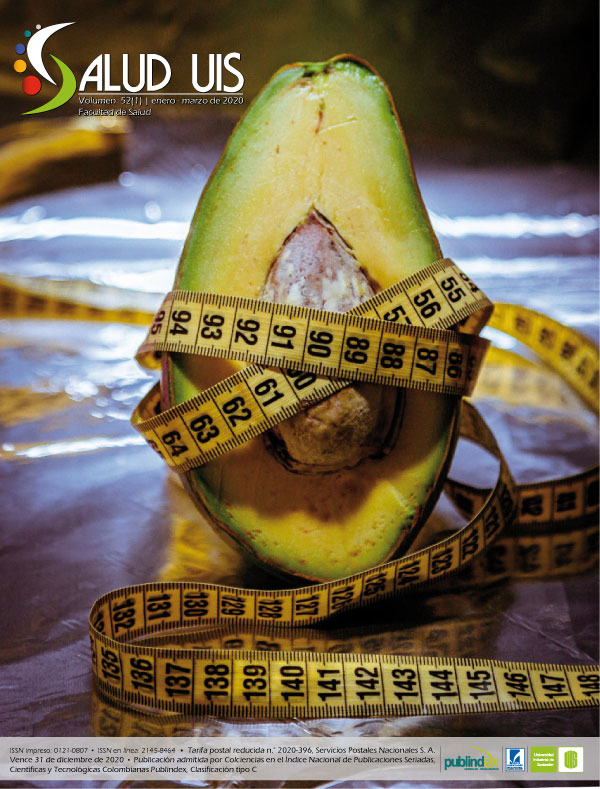Abstract
Introduction: The OPT model (Outcome Present State Test) raises the importance of reorienting the teaching and learning of the nursing process when thinking about it in broader, panoramic and reflective terms; it facilitates the development of clinical reasoning skills, which is a breakthrough for teaching and practice in making clinical
decisions that integrate NANDA, NIC and NOC. The new guidelines structured from the OPT model, overcome the linear, fractional and instrumental vision of the five stages of the nursing process. Objective: To compare two nursing process application models (generation 2 and generation 3), in the elaboration of care plans by students of the nursing program of a higher education institution of Bucaramanga (Colombia). Methodology: Cross-sectional study. With participation of 33 students from the fifth level of UIS nursing program UIS. Variables were defined and the instruments to evaluate and compare the application of the nursing process of the second and third generations were designed. Results: Preference for the third generation model was identified as a guide for addressing clinical cases; however, it is important to note that the students did not find significant differences in aspects of theoretical articulation, nor in the application of NIC and NOC languages. Students find significant differences in the use of OPT model in aspects related to clinical reasoning, case essence determination, diagnostic support and in the nursing diagnosis identification. Conclusions: Expanding the teaching of the OPT model in all courses of the nursing program UIS, will facilitate a greater understanding of the student’s thinking processes and a greater ability to adapt experiences to meet individual learning needs; it will also strengthen the curriculum and therefore the teaching practices.
References
2. Pesut DJ. 21ts century nursing knowledge work: reasoning into the future. In Weaver C, Delaney CW, Wewber P, Carr R. (1st ed.) Nursing and informatics for the 21st century: an internacional look at practice, trends and the future. 2006. pp.13-23. Chicago IL: HIMSS.
3. Herman H. Clasificación completa de diagnósticos enfermeros NANDA-I 2015-2017. https://www.salusplay.com/blog/diagnosticos-enfermerosnanda-2017/.
4. Bulecheck G, Butcher HK, Dochterman J. Nursing Interventions Classification (NIC) - 5th Ed. 2013. https://www.elsevier.com/books/nursing-interventions-classification-nic/
bulechek/978-0-323-05340-2.
5. Moorhead Sue, Jhonsson M, Maas M, Swansson E. Nursing Outcomes Classification (NOC) - 5th Edition. 2012. https://www.elsevier.com/books/nursing-outcomes-classification-noc/
moorhead/978-0-323-10010-6.
6. Bartlett R, Bland A, Rossen E, Kautz D, Benfield S, Carnevale T. Evaluation of the outcome present state test model as a way to teach clinical reasoning. 2008; 47(8): 337-344. doi: https://doi.org/10.3928/01484834-20080801-01.
7. da Costa CPV, Luz MHBA. Digital learning object for diagnostic reasoning in nursing applied to the integumentary system. Rev Gaucha Enferm. 2015; 36(4): 55-62. doi: https://doi.org/10.1590/1983-1447.2015.04.54128.
8. Kautz DD, Kuiper R, Pesut DJ, Williams RL. Using NANDA, NIC, and NOC (NNN) language for clinical reasoning with the Outcome-Present State-Test (OPT) model. Int J Nurs Terminol Classif. 2006;17(3): 129-138. doi: https://doi.org/10.1111/j.1744-618X.2006.00033.x.
9. Pink DH. A whole new mind: moving from the information age to the conceptual age. New York :Riverhead Books; 2005. p282 . http://archive.org/details/wholenewmindmovi00pink.
10. Herdman H, Kamitsuru S. NANDA International Nursing Diagnoses: definitions and classification 2015 - 2017; 2015. https://www.wiley.com//legacy/wileychi/nanda/?type=Home.
11. Cowen PS, Moorhead S. Current issues in nursing. St. Louis Mo. Mosby Elsevier; 2011.
12. Kautz D, Kuiper RA, Pesut DJ, Knight-Brown P. Promoting clinical reasoning in undergraduate nursing students: application and evaluation of the outcome present state test (OPT) model of clinical reasoning. Int J Nurs Educ Scholarsh. 2005; 2(1): 1548-923X doi: https://doi.org/10.2202/1548-923X.1052.
13. Ibáñez LE, Amaya de Gamarra IC, Niño Bautista L. El proceso de rediseño curricular en el Programa de enfermería de la UIS. Una propuesta Innovadora. Salud UIS. 2002; 34(2): 128-137.
14. Alfayoumi I. The impact of combining concept based learning and concept-mapping pedagogies on nursing students’ clinical reasoning abilities. Nurse Educ Today. 2019; 72: 40-46. doi: https://doi.org/10.1016/j.nedt.2018.10.009.
15. Jael SA. Use of Outcome-Present state test model of clinical reasoning with Filipino nursing students. Loma Linda University Elect Theses, Dissertations & Projects. 387.
https://scholarsrepository.llu.edu/etd/387.
16. Kaddoura M, Van-Dyke O, Yang Q. Impact of a concept map teaching approach on nursing students’ critical thinking skills. Nurs Health Sci. 2016; 18(3): 350-354. doi: https://doi.org/10.1111/nhs.12277.
17. Griggs K, Arms T. Outcome-Present State Test Model for Expanding Students’ Clinical Reasoning. Nurse Educator. 2019; 44(3). doi: 10.1097/NNE.0000000000000578.
18. Carvalho EC, de Souza Oliveira-Kumakura AR, Coelho Ramalho Vasconcelos Morais S. Clinical reasoning in nursing: teaching strategies and assessment tools. 2017; 70(3): 662-668. doi: https://doi.org/10.1590/0034-7167-2016-0509.
19. Tampy H, Willert E, Ramani S. Assessing Clinical Reasoning: targeting the higher levels of the pyramid. J Gen Intern Med. 2019; 34(8): 1631-1636. doi: https://doi.org/10.1007/s11606-019-04953-4.
20. Bland AR, Rossen EK, Bartlett R, Kautz DD, Carnevale T, Benfield S. Implementation and testing of the OPT MODEL as a teaching strategy in an undergraduate psychiatric nursing course. 2009; 30(1): 14-21.
21. Murphy JI. Using focused reflection and articulation to promote clinical reasoning: An evidence-based teaching strategy. Nurs Educ Perspect. 2004; 25(5): 226-231.
22. Kuiper RA. Integration of innovative clinical reasoning pedagogies into a baccalaureate nursing curriculum. Creat Nurs. 2013; 19(3): 128-139. doi: https://doi.org/10.1891/1078-4535.19.3.128.
23. Roca Llobet J. El Desarrollo del pensamiento crítico a través de diferentes metodologías docentes en el Grado en Enfermería. Universitat Autònoma de Barcelona; 2014. http://hdl.handle.net/10803/129382.
24. Simmons B. Clinical reasoning: concept analysis. J Adv Nurs. 2010; 66(5): 1151-1158. doi: https://doi.org/10.1111/j.1365-2648.2010.05262.x.
25. Rifà Ros R, Pérez Pérez I. Application of an OPT model in a paediatric nursing clinical case in primary health care. Enferm Clin. 2011; 21(3): 168-172. doi: https://doi.org/10.1016/j.enfcli.2010.10.013.
Se autoriza la reproducción total o parcial de la obra para fines educativos, siempre y cuando se cite la fuente.
Esta obra está bajo una Licencia Creative Commons Atribución 4.0 Pública Internacional.
